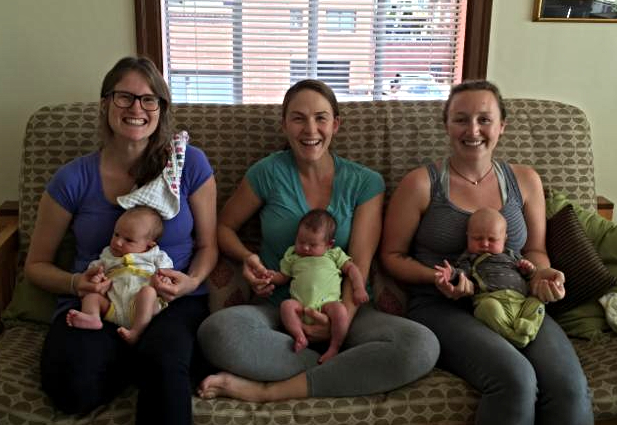So, you’ve had your baby. You’re feeling up to exercise, but you don’t quite know what you should and shouldn’t be doing when it comes down to it. You know certain areas of your body have been affected, but how do you know what to strengthen, what to stretch, and what to focus on?
As a Pre & Postnatal Specialist, I prefer new moms to return to an exercise class that is designed specifically for them before returning to mainstream classes.
Several postural changes occur in the body during pregnancy, and it’s important that postpartum women target muscles that have weakened and lengthened (or weakened and tightened) to help strengthen, re-align and bring them back to their optimum position again.
Below, I’ve summarized what a Postpartum Session should include; you will find all these components at Small Group Training with Bodies for Birth:
GLUTE STRENGTHENING EXERCISES
Your glutes actually lengthen and weaken during pregnancy because your pelvis tips forwards to allow your ever-growing bump to come forward, so your bottom is definitely on the list of muscles you want to focus on after birth.
And, why wouldn’t you?!
It’s important to do exercises for the glutes that keep the pelvis stable by activating the core muscles too though. Any strengthening exercise performed for these sets of muscles should be done so in a slow, controlled manor, ensuring your technique and pelvic positioning is maintained.
Exercises such as squats and lunges are ideal, but there are a few watch points to consider, especially for your lower back when performing them. So, make sure your pelvic floor/core is switched on, keep the lower back from arching, and perform the exercises slowly and with control, for maximum results.
ABDOMINALS
The abdominals weaken and lengthen during pregnancy, and I’m specifically talking about the six-pack muscle which runs from your breastbone, to your pubic bone, vertically down the front of your stomach. Sometimes these muscles separate, but not in all pregnancies.
The deep, internal abdominal muscle called the Transverse Abdominis, sometimes referred to as your “core” muscle should be your main focus.
Sit ups aren’t suitable for postnatal women to do, so stop them immediately if you are, and neither are forceful rotational movements where you twist your torso from right to left.
It’s safer to perform exercises which target the pelvic floor and deep abdominal muscles or “core”, as these help stabilize your pelvis and the exercises themselves have numerous benefits.
UPPER BACK STRENGTHENING EXERCISES
This may seem a peculiar area of a new mom’s body to mention, but, during pregnancy, you may have noticed that your shoulders have rounded slightly, because your breasts enlarge and your center of gravity is shifted forwards, causing your shoulders to round.
What’s happening at the upper back (specifically the lower Trapezius muscle) is that the muscles here are busy weakening and lengthening to separate your shoulder blades further apart from each other, and in turn they’re tightening your chest at the front.
If you strengthen your upper back, the shoulder blades will return to a more optimum position, i.e.: closer together.
The other reason I do a lot of upper back work in my postnatal classes is because everything you do as a new mom involves you leaning forwards/rounding your shoulders even more, i.e.: feeding baby, pushing your stroller, lifting your baby up, changing baby etc, so there’s method in my madness here!
Almost all women report “needing” these exercises and feeling so much better once completed!
CHEST STRETCHING EXERCISES
Now, while your upper back is busy weakening, your chest/front of your shoulders are busy tightening (and weakening).
As I mentioned above, you need to incorporate upper back strengthening exercises to combat rounded shoulders, but, you also need to stretch out the front of your shoulders/chest too, because these muscles get overused and need to be released. So after any exercise, always do a chest stretch by placing your arms/hands behind you. Be careful not to arch your lower back or thrust your chest and keep your chin lifted, so as not to put strain on your neck.
HIP OPENING EXERCISES
So, we touched on the glutes earlier. Do you remember what happens to them? That’s right – they weaken and lengthen. While they’re doing this, your poor hip flexors at the front of your hips are busy getting tighter and tighter as your pregnancy develops, to accommodate baby bump at your front.
So, again, this is another area of the body that needs some attention when it comes to stretching or cool down. If you sit down a lot, your hip flexors are in a state of contraction, so stretching these muscles out really helps bring your pelvis back into alignment again.
Remember with any stretch, you don’t want to hold it for more than 10-15 seconds; don’t bounce or jerk; and remember to breathe (never going to a place of pain or discomfort).
And, there you have it. Lots to consider, isn’t there? I hope you enjoyed reading this information and to see you in Postpartum Group Training where we will build a fantastic foundation for returning to fitness! If you found this helpful, why not share?!
[hr]Work with me one-on-one for an individualized program to reach your health and fitness goals! You can work with me one-one-one via Skype or in-person. Visit www.bodiesforbirth.com to learn more!
[hr]Check out the Bodies for Birth page on Facebook for daily posts this week regarding prenatal fitness! Join our private Facebook group for ongoing access to me, to connect with other moms, for answers to your questions, for support and resources!
Claire Mockridge is a qualified and experienced Personal Trainer, Fitness Instructor and Pilates Teacher with a passion for fitness and wellbeing. Teaching general exercise and Pilates classes in West Bridgford, Nottingham, Claire has a specialism in pregnant and postnatal fitness. See more at: http:www.clairemockridge.com


